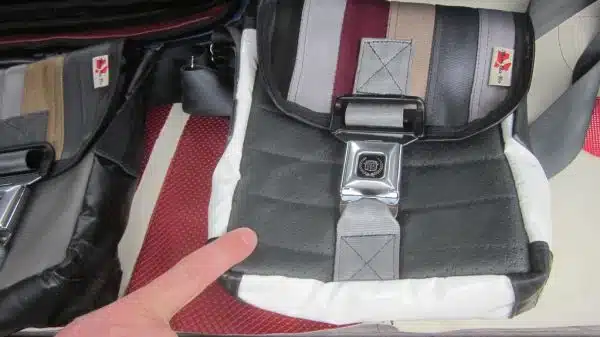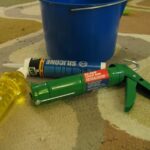As a specialist in leather car seat cleaning, it is essential to understand the proper techniques and tools required to maintain the pristine condition of your vehicle’s upholstery. Leather seats are a luxurious addition to any car, but they can also be one of the most challenging parts of your car’s interior to keep clean. Proper care and maintenance are crucial in ensuring the long-lasting quality and appearance of your leather car seats.
Cleaning leather car seats requires more than just wiping them down with a damp cloth. It is important to use specific products and techniques that are gentle on the leather while still effectively removing dirt, stains, and grime. In this article, we will explore some tips and tricks for cleaning leather car seats properly. We’ll cover everything from preparing your seats before cleaning to the best products to use for different types of stains. By following these guidelines, you can maintain your car’s luxurious look and feel while prolonging the life of your leather upholstery.
Understanding The Importance Of Proper Leather Car Seat Maintenance
Proper maintenance of leather car seats is crucial to ensure their longevity and appearance. Leather is a natural material that requires special care to maintain its suppleness and prevent cracking or discoloration over time. One essential aspect of this care is the use of high-quality leather conditioner. A good conditioner will help keep the leather supple and hydrated, protecting it from damage caused by dryness or exposure to sunlight.
Aside from using leather conditioner, there are also various options for protecting your car’s leather seats from wear and tear. One option is to invest in seat covers made specifically for your vehicle’s make and model. These covers can provide an additional layer of protection against spills, stains, and scratches while adding a touch of personal style to your car’s interior.
However, it’s worth noting that not all seat covers are created equal, and some may not be suitable for use with leather seats. It’s always best to research different types of covers before making a purchase or consulting with a specialist who can advise on the best options for your particular car.
Proper maintenance and protection of your leather car seats can help preserve their appearance and prolong their lifespan. In the next section, we’ll discuss how to prepare your car for cleaning these seats effectively without causing any damage or discoloration.
Preparing Your Car For Leather Seat Cleaning
Just as a chef prepares ingredients before cooking a meal, it is essential to prepare your car before cleaning the leather seats. A pre-cleaning inspection is necessary to identify any areas that require special attention, such as stains or scratches. This inspection ensures that you have the right cleaning tools and products to achieve the desired results.
Cleaning tools are an essential part of preparing your car for leather seat cleaning. You should have microfiber towels, a soft-bristle brush, and a vacuum cleaner. Microfiber towels are ideal for wiping away dirt and grime without scratching the surface of the leather. A soft-bristle brush helps remove dirt from crevices and tight spaces while being gentle on the leather. Finally, use a vacuum cleaner to remove any loose debris before starting the cleaning process.
During a pre-cleaning inspection, check for any stains or spills that need extra attention. You can use three sub-lists to help you tackle these areas effectively:
- Grease stains: Use baking soda or cornstarch to absorb grease from the surface of the leather.
- Ink stains: Apply rubbing alcohol with a cotton swab to remove ink marks from the surface.
- Food or drink spills: Blot up any excess liquid with a microfiber towel, then clean with mild soap and water.
Now that you have prepared your car for leather seat cleaning by inspecting it and gathering your tools let’s move on to choosing the right cleaning products in our next section.
Choosing The Right Cleaning Products
When it comes to cleaning leather car seats, choosing the appropriate cleaning tools is crucial. Not all cleaning products are suitable for leather, and using the wrong ones can lead to damage or discoloration. Therefore, it is vital to choose a cleaner that is specifically designed for use on leather car seats.
One tip for avoiding damage when cleaning leather car seats is to avoid using harsh chemicals or abrasive materials. These can cause scratches and cracks in the leather, leading to costly repairs down the line. Instead, opt for gentle cleaners that are pH balanced and contain natural ingredients like lanolin or coconut oil.
Another tip is to always test the cleaner on a small, inconspicuous area of the seat first before applying it more broadly. This will help you avoid any unexpected reactions or damage to the leather. By following these tips and selecting appropriate cleaning products, you can safely clean your leather car seats without causing harm.
Moving forward into our next section about ‘leather seat cleaning do’s and don’ts,’ we will explore specific actions you should take or avoid when cleaning your leather car seats. By following these guidelines, you can ensure that your seats remain in top condition and continue to look great for years to come.
Leather Seat Cleaning Do’s And Don’ts
As a leather car seat cleaning specialist, it is important to know the do’s and don’ts of leather seat cleaning. Leather seats are a luxurious addition to any car, but they require proper care and maintenance to ensure their longevity. One of the most important things to remember is to always use a leather conditioner after regular cleaning.
Using a leather conditioner will help keep your seats from drying out and cracking over time. It also helps maintain the natural oils in the leather that give it its softness and luster. Be sure to choose a conditioner specifically designed for automotive leather seats, as other types of conditioners may not be suitable.
In addition, when cleaning your leather seats, avoid using harsh chemicals or abrasive materials such as bleach or steel wool. These can damage the surface of the leather, causing it to crack or fade. Instead, use a mild cleaner specifically designed for automotive leather and a soft-bristled brush or microfiber towel.
- Always use a leather conditioner after regular cleaning.
- Choose a conditioner specifically designed for automotive leather seats.
- Avoid using harsh chemicals or abrasive materials.
Next, we will discuss how to remove dirt and dust from your leather car seats without causing any damage.
Removing Dirt And Dust From Leather Car Seats
One of the most important aspects of maintaining leather car seats is regular cleaning. Dirt and dust can accumulate on the surface of the leather, causing it to break down over time. To remove dirt and dust from your leather car seats, start by using a soft-bristled brush or microfiber cloth to gently sweep away any loose debris.
Next, you’ll want to use a leather cleaner specifically designed for car seats. Avoid using harsh chemicals or household cleaners that could damage the leather. Apply the cleaner to a clean microfiber cloth and gently rub it into the surface of the leather in circular motions. Be sure to follow the manufacturer’s instructions for application and drying time.
After cleaning your leather car seats, it’s important to condition them to keep them looking their best. Leather seat conditioning helps protect against wear and tear while also keeping the leather supple and soft. Preventive maintenance techniques like regularly cleaning and conditioning your leather car seats can help extend their lifespan so you can enjoy them for years to come.
Transition: Now that you know how to keep your leather car seats clean and conditioned, let’s move on to treating stains that may occur over time.
Treating Stains On Leather Car Seats
When it comes to maintaining the appearance of your leather car seats, preventing stains is key. While accidents can happen, there are some steps you can take to minimize the risk of staining. For example, be mindful of what you bring into your car and avoid eating or drinking while sitting in your car. Additionally, if you have children or pets who regularly ride in your car, consider investing in protective seat covers.
Despite our best efforts to prevent stains, they can still occur. When dealing with a stain on your leather car seats, it’s important to act quickly. The longer a stain sits on the leather surface, the more difficult it will be to remove. Start by blotting up any excess liquid with a clean cloth or paper towel. Avoid rubbing the stain as this can push it further into the leather.
After removing any excess liquid from the stain, you may want to consider using a leather conditioner specifically designed for car seats. Applying a conditioner can help protect against future stains and also restore moisture to the leather surface. Be sure to follow the manufacturer’s instructions when applying any product to your leather car seats. By taking these steps and being proactive about preventing stains, you can help extend the life of your leather car seats and keep them looking their best for years to come.
As much as we try to prevent them, grease and oil stains are another common issue that can arise on leather car seats. In the next section, we’ll explore some tips for effectively removing these types of stains without causing damage to your leather surface.
Dealing With Grease And Oil Stains
Grease and oil stains can be a nightmare to clean from leather car seats, but with the right approach, it is possible to remove them effectively. Firstly, it is important to tackle the stain as soon as possible. The longer you wait, the harder it will be to remove the grease or oil buildup from the surface of your leather seats.
To remove grease stains from leather car seats, start by blotting up any excess grease using a clean cloth or paper towel. Next, mix a few drops of mild dish soap with warm water and use a soft-bristled brush to gently scrub the stained area. Be sure not to scrub too hard or you could damage the leather. Rinse with a clean damp cloth and then dry thoroughly.
Preventing oil buildup on your leather car seats is key to avoiding future stains. One way to do this is by regularly wiping down your seats with a microfiber cloth to remove any excess oil or dirt. It’s also a good idea to treat your leather seats with a protective spray that can repel oils and liquids. By taking these preventative measures, you can keep your leather car seats looking their best for years to come.
Now that we’ve covered how to deal with grease and oil stains on leather car seats, let’s move on to another common issue: removing ink stains.
Removing Ink Stains From Leather Car Seats
- Before cleaning leather car seats, it is important to remove any loose dirt and debris and vacuum the seat thoroughly.
- To remove an ink stain, a damp cloth should be used with a leather cleaning solution and gently rubbed in a circular motion on the stain until it is removed.
- Once the ink stain has been removed, the cleaning solution should be wiped away with a damp cloth and then dried with a separate dry cloth.
- It is important to apply a leather conditioner to the seat after cleaning to help preserve the leather and prevent further damage.
- A leather protector can also be applied to the seat after it is dry to help prevent future stains and fading from sun exposure.
- Finally, all of the cleaning supplies should be removed from the car and stored in a safe place for future use.
Preparing The Seat
As a leather car seat cleaning specialist, one of the most challenging problems that I have encountered is dealing with ink stains. However, with proper preparation, it is possible to remove these stains without causing any damage to the leather. Before attempting to remove the stain, it is essential to clean the seat thoroughly.
The first step in preparing the seat is to vacuum it using a soft brush attachment. This will help remove any dirt or debris that may be on the surface of the leather. Next, use a gentle cleaner designed for leather car seats to wipe down the entire surface of the seat. This will help remove any oils or residues that may prevent the ink remover from working effectively.
After cleaning the seat, it is crucial to apply conditioner to restore its natural oils and protect it from future damage. Finally, when working on removing ink stains from leather car seats, using protective covers such as gloves and masks can help prevent skin irritation and inhalation of harmful chemicals. By taking these steps before attempting to remove an ink stain, you can ensure that your leather car seat remains clean and undamaged during the process.
Removing The Stain
Now that the leather car seat has been thoroughly cleaned and prepped, it’s time to focus on removing the ink stain. One of the most common types of ink stains that I come across is from ballpoint pens. To remove these stains, start by applying a small amount of rubbing alcohol to a clean cloth and gently dabbing the affected area. Be careful not to rub too hard as this can damage the leather. Repeat this process until the stain has lifted.
If you’re dealing with wine stains or coffee spills, the process for removing them is slightly different. Begin by soaking up as much of the liquid as possible using a clean towel or cloth. Then, mix together equal parts water and white vinegar and apply it to the stained area using a clean cloth. Gently rub in circular motions until the stain has lifted.
It’s important to note that ink stains can vary in severity, so it may take several attempts before they are completely removed. In some cases, it may be necessary to use a specialized leather cleaner designed for ink removal. As with any cleaning product, be sure to follow the manufacturer’s instructions carefully and test it on an inconspicuous area first. With patience and persistence, you can successfully remove ink stains from your leather car seats without causing any damage or discoloration.
Finishing The Cleaning Process
After successfully removing ink stains from leather car seats, the next step is to finish the cleaning process. This involves using a buffing technique to restore the leather’s shine and texture. A soft cloth can be used to buff the seats gently in circular motions. Buffing helps to evenly distribute any remaining cleaning solution and remove any excess dirt or grime.
Once the seats have been buffed, it’s time to apply a leather conditioner. This will help moisturize and protect the leather from future damage caused by drying out or cracking. Apply a small amount of conditioner to a clean cloth and rub it into the leather in circular motions. Be sure not to use too much conditioner as this can leave a greasy residue on the seats.
After applying conditioner, let it sit for a few minutes before wiping off any excess with a clean cloth. This will ensure that the leather is properly moisturized without leaving behind any residue. By following these steps, you can effectively remove ink stains from your leather car seats and give them a refreshed look with added protection against future damage.
Cleaning Pet Hair And Stains From Leather Car Seats
When it comes to cleaning leather car seats, pet hair and stains can be a real challenge. Pet hair can become embedded in the leather, while tough stains may require more than just a simple wipe down. To effectively clean pet hair and stains from leather car seats, it’s important to have the right tools and techniques.
To start, vacuum the seats thoroughly to remove any loose pet hair. For stubborn fur that is stuck to the leather, use a rubber glove or damp cloth to rub it in one direction until it lifts off. As for tough stains, avoid using harsh chemicals or abrasive cleaners as they can damage the leather. Instead, use a specific leather cleaner made for your type of seat and follow the instructions carefully.
For particularly stubborn stains such as ink or blood, try using rubbing alcohol on a cotton swab or cloth. Gently dab the stain until it lifts off without rubbing too hard as this can cause further damage. Remember to always test any cleaning product on an inconspicuous area first before applying it to the entire seat.
By following these tips and techniques for cleaning pet hair and tough stains from leather car seats, you can ensure that they look their best for years to come. In our subsequent section, we’ll discuss how to maintain the shine and suppleness of your leather car seats with some easy upkeep tips.
Maintaining The Shine And Suppleness Of Leather Car Seats
- Leather car seats are a luxurious addition to any vehicle and need special care to ensure they maintain their shine and suppleness.
- Protecting leather seats from dirt and debris is key to keeping them looking new and preserving their condition.
- Cleaning leather car seats should be done regularly with a mild soap and soft cloth, avoiding harsh chemicals and abrasive brushes.
- For difficult-to-remove stains, a leather cleaning product should be used to gently treat the affected area.
- Conditioning leather car seats is essential to keeping them soft and supple, and helps to prevent cracking.
- Regular maintenance will ensure leather car seats continue to look and feel their best for many years to come.
Protecting Leather Seats
As a leather car seat cleaning specialist, I understand the importance of maintaining the shine and suppleness of leather seat covers. One of the most crucial aspects of preserving leather seats is by protecting them. Protecting your leather seats can not only help maintain their appearance but also extend their lifespan. To do this, it is essential to use high-quality leather seat care products that are specifically designed for this purpose.
There are various types of leather seat care products available in the market that offer different levels of protection for your car’s leather seats. Some products provide a protective barrier against dirt and stains, while others offer UV protection to prevent fading and cracking caused by exposure to sunlight. It is recommended to choose a product that suits your specific needs and the type of leather used in your car’s seats.
In conclusion, protecting your car’s leather seats using appropriate care products should be an integral part of your maintenance routine. It will not only enhance the appearance but also protect the investment you made in purchasing a quality vehicle with premium interior features like leather seats. Therefore, it is always better to consult with a professional who can guide you in choosing the best products suitable for your car’s specific needs.
Cleaning Leather Seats
As a leather car seat cleaning specialist, I know that cleaning leather seats is an essential part of maintaining their shine and suppleness. It is important to keep in mind that improper cleaning techniques can damage the leather and reduce its lifespan. Therefore, it is crucial to use appropriate products and methods for cleaning your car’s leather seats.
One of the best ways to clean leather seats is by using a high-quality leather seat conditioning product. This product can help remove dirt, grime, and stains from the surface of the leather while also nourishing and moisturizing it. However, it is important to follow the manufacturer’s instructions carefully and avoid using harsh chemicals or abrasive materials that can cause damage.
If you prefer DIY leather seat cleaning tips, then there are some simple methods you can use at home. For instance, you can mix equal parts of water and white vinegar in a spray bottle and apply it to the leather seats. Then wipe with a soft cloth or sponge. Another effective method involves using a mixture of mild dish soap and warm water with a microfiber cloth or sponge to gently clean the surface of the seat. Remember not to use too much water as excess moisture can cause damage to the leather.
Cleaning your car’s leather seats regularly will not only keep them looking shiny and new but also extend their lifespan. By following these simple tips, you can maintain your car’s premium interior features like leather seats for years to come.
Conditioning Leather Seats
Maintaining the shine and suppleness of leather car seats is crucial to keep them looking new and extend their lifespan. In addition to regular cleaning, conditioning leather seats is an essential part of their maintenance. As a leather car seat cleaning specialist, I recommend applying conditioner to the leather seats regularly to prevent cracking and preserve their appearance.
Applying conditioner helps maintain the natural oils in the leather, which can evaporate over time due to heat or sunlight exposure. When these oils dry out, the leather becomes stiff and prone to cracking. Conditioning replenishes these oils, preventing cracking and keeping the leather supple. Moreover, it protects the leather from stains and spills by creating a barrier on its surface.
To apply conditioner correctly, use a clean microfiber cloth or sponge and follow the manufacturer’s instructions carefully. Apply a small amount of conditioner onto the cloth or sponge, then rub it into the leather in circular motions. Let it sit for a few minutes before wiping off any excess with another clean cloth or sponge. Use conditioner once every three months or as often as recommended by your car’s manual.
In conclusion, maintaining the shine and suppleness of your car’s leather seats goes beyond just cleaning them regularly. Applying conditioner protects against cracking and preserves their appearance for years to come. By following these tips from a leather car seat cleaning specialist, you can keep your car’s interior looking luxurious while serving your subconscious desire for serving others through proper maintenance practices.
Protecting Leather Car Seats From Sun Damage
One of the biggest concerns for leather car seat owners is sun damage. Sun exposure can cause the leather to crack and fade, ultimately reducing the lifespan of your seats. Fortunately, there are steps you can take to prevent this type of damage.
One way to protect your leather car seats from sun damage is by applying a leather conditioner regularly. Leather conditioner helps keep the leather soft and supple, preventing it from drying out and cracking due to sun exposure. Be sure to choose a conditioner that is specifically formulated for automotive leather, as these products contain UV inhibitors that help block harmful rays.
Another important step in preventing cracking and fading caused by sun exposure is to park your car in a shaded area whenever possible. If you don’t have access to covered parking, consider investing in a windshield shade or tinted windows. These items can help reduce the amount of sunlight that enters your car’s interior, which will ultimately help protect your leather seats.
To keep your leather car seats looking their best for years to come, it’s important to take preventative measures against sun damage. By regularly applying a high-quality leather conditioner and parking in shaded areas when possible, you can ensure that your seats will remain soft, supple and free from cracks and fading caused by the sun’s harmful rays. In the next section, we’ll discuss some common mistakes people make when cleaning their leather car seats – so be sure to read on!
Avoiding Common Mistakes In Leather Car Seat Cleaning
While protecting your leather car seats from sun damage is crucial, it’s equally important to avoid common mistakes during the cleaning process. One of these mistakes is using the wrong type of leather seat cleaners. Always make sure to use a cleaner specifically designed for leather car seats, as using products meant for other materials can cause damage.
Another mistake is not testing the cleaner first before applying it to the entire surface of your car seat. Different types of leather react differently to cleaning solutions, so it’s essential to test a small, inconspicuous area first. This will ensure that you don’t end up damaging your entire car seat by using an incompatible product.
Finally, never scrub too hard when cleaning your leather car seats. Leather is delicate and can easily scratch or tear if you’re too rough with it. Instead, apply gentle pressure and use a soft-bristled brush or cloth to clean away dirt and grime. By avoiding these common mistakes, you can keep your leather car seats looking like new for years to come.
Moving forward, let’s discuss how to clean leather car seats in different climates. Whether you live in a hot and dry desert region or a cold and damp coastal area, there are specific cleaning techniques that work best for each climate type. Let’s take a closer look at how you can maintain your precious leather car seats no matter where you live!
Cleaning Leather Car Seats In Different Climates
Cleaning leather car seats in hot climates is best done using a solution of lukewarm water and a mild detergent. A soft brush should be used to gently scrub the surface of the seat. In cold climates, a leather cleaner should be used to clean the seat, as it will prevent the leather from drying out and cracking. In humid climates, a combination of a leather cleaner and a soft cloth should be used to clean the seats, as well as a leather conditioner to help protect the seat. Leather car seats should never be exposed to direct sunlight or other sources of heat, as this can cause damage to the leather. Finally, leather car seats should be vacuumed and wiped down regularly to help remove any dirt or debris that may accumulate.
Cleaning In Hot Climates
As a leather car seat cleaning specialist, I understand that cleaning leather car seats in hot climates can be a challenging task. However, preventing fading and avoiding cracking of the leather is essential for maintaining the longevity and appearance of the seats. To prevent fading, it is recommended to park the car in a shaded area or use a sunshade when parking under direct sunlight. Additionally, applying a quality leather conditioner regularly will help keep the leather moisturized and prevent drying out.
In hot climates, avoiding cracking in the leather car seats is crucial to keeping them looking new. The best way to avoid this is by keeping the interior temperature of your car cool as much as possible. You can achieve this by using air conditioning or cracking open windows when parked to allow heat to escape from inside. It is also important to avoid leaving sharp objects on the seats that could potentially scratch or puncture them.
Lastly, when cleaning leather car seats in hot climates, it’s essential to use only high-quality products designed specifically for leather cleaning. Avoid harsh chemicals that could damage or dry out the material further. Instead, opt for gentle cleaners with moisturizing properties that will help maintain the suppleness of your leather seats. By following these tips, you can help protect your leather car seats from fading and cracking in even the hottest climates while still providing optimal comfort and style for your ride.
Cleaning In Cold Climates
As a leather car seat cleaning specialist, I understand that the preservation of leather seats is essential in different climates. When it comes to winter cleaning tips, it is crucial to know how to care for your leather car seats in freezing temperatures. Leather is prone to drying out and cracking in cold weather, so proper maintenance is necessary to keep them looking new.
To preserve leather seats in freezing temperatures, it’s essential to avoid exposing them to extreme cold or moisture. Park the car in a garage or covered area when possible to protect it from snow and ice. If you must park outside, consider using a high-quality seat cover that fits properly over your leather seats. This can help prevent moisture buildup on the surface of the leather.
When cleaning leather car seats in cold climates, use products specifically designed for use during winter months. Avoid using harsh chemicals or abrasive materials as they can damage and dry out the material further. Instead, opt for gentle cleaners with moisturizing properties that will keep your seats supple and protected against dryness caused by low temperatures. By following these tips, you can help ensure that your leather car seats stay looking their best even during the coldest months of the year.
Cleaning In Humid Climates
As a leather car seat cleaning specialist, I understand the importance of maintaining leather seats in various climates. In addition to winter cleaning tips, it is essential to know how to care for your leather car seats in humid climates. Leather is susceptible to mildew growth and moisture damage in high humidity, making proper maintenance crucial.
To prevent mildew growth on your leather car seats in humid climates, it’s important to keep them dry at all times. Avoid leaving wet items, such as towels or clothing, on the seats for extended periods. If you live in an area with high humidity levels, consider using a dehumidifier in your garage or covered parking area. This will help reduce the amount of moisture that can accumulate on your leather seats.
When cleaning leather car seats in humid climates, use products specifically designed for use during these conditions. Avoid using harsh chemicals or abrasive materials that can further dry out and damage the material. Instead, opt for gentle cleaners with conditioning properties that will help protect the leather from moisture damage caused by high humidity levels. By following these tips, you can help ensure that your leather car seats stay looking their best even during the most humid months of the year.
Hiring Professional Leather Car Seat Cleaners
Hiring professional leather car seat cleaners to clean your seats is an excellent option for those who may not have the time, expertise, or equipment to do it themselves. Professional leather cleaners are well-versed in the different types of leather and the appropriate cleaning methods for each. By hiring professionals, you can ensure that your car seats will be cleaned thoroughly without the risk of damage.
One benefit of hiring professional leather car seat cleaners is that they use specialized equipment and cleaning solutions that are not readily available to consumers. These products are designed specifically for leather and can effectively remove dirt, grime, and stains without causing any harm to the material. Additionally, professional cleaners have extensive knowledge about how to care for leather in order to prolong its life.
While there are costs associated with hiring professionals to clean your leather car seats, it is important to consider the value you receive in return. Not only will your seats look brand new after being professionally cleaned, but you also save time and effort by not having to do it yourself. In addition, by properly maintaining your leather seats through regular professional cleaning, you can avoid costly repairs or replacements down the road.
Moving forward into frequently asked questions about leather car seat cleaning, one common concern is whether or not professional cleaning will damage the leather. It is important to note that professional cleaners have specific training and experience in dealing with various types of leather materials. They know which methods and products work best for each type of leather, ensuring that it is cleaned thoroughly while also being protected from damage.
Frequently Asked Questions About Leather Car Seat Cleaning
Many car owners are hesitant to clean their leather car seats themselves, fearing that they may damage or ruin the material. However, with proper leather seat care and DIY cleaning tips, it is entirely possible to clean your car’s leather seats effectively without causing any harm. In this section, we will address some frequently asked questions about leather car seat cleaning.
One common question is whether or not it is safe to use household products like soap and water to clean leather car seats. While it may be tempting to use these readily available items, it is best to avoid them altogether. Soap can strip the natural oils from the leather and cause it to crack over time. Instead, opt for a specifically formulated cleaner designed for leather upholstery.
Another popular inquiry concerns how often one should clean their car’s leather seats. This answer varies depending on usage levels and other factors such as exposure to sunlight and humidity levels. As a general rule of thumb, though, you should aim to clean your leather seats at least twice per year thoroughly. Additionally, regular wiping down with a microfiber cloth can prevent dirt buildup and help maintain their appearance in between deep cleaning sessions.
| Myths About Cleaning Leather Car Seats | Facts |
|---|---|
| You Can Use Household Cleaners | Incorrect – Use Specifically Formulated Cleaners |
| Baby Wipes Are Safe To Use | False – They Can Leave Residue And Dry Out The Leather |
| You Only Need To Clean Them Once A Year | Incorrect – Aim To Clean Twice A Year Thoroughly |
As you can see from the table above, there are many myths surrounding the proper care of leather car seats. It’s essential to do your research and invest in high-quality products designed for this specific purpose. With consistent maintenance and appropriate cleaning techniques, you can keep your car’s interior looking beautiful for years to come without damaging the material or causing any unnecessary wear and tear.
Conclusion
Proper maintenance of leather car seats is crucial to keep them in pristine condition. Leather car seats are not only luxurious but also durable and long-lasting. They add elegance to the interior of your car and enhance its overall value. However, without proper care, they can become dull and lose their luster.
Before you start cleaning your leather car seats, make sure to prepare adequately. Choose the appropriate cleaning products that will not damage the leather’s delicate surface. Remember, harsh chemicals can cause irreparable damage to your leather car seats.
Cleaning your leather car seats requires careful attention to detail. Ensure that you clean all crevices and surfaces thoroughly. Avoid using abrasive materials or scrubbing too hard as this may cause scratches or scuffs on the leather.
When it comes to maintaining your leather car seats, prevention is better than cure. Regular cleaning and conditioning can prevent dirt build-up and ensure that your leather remains soft and supple for years to come.
As a specialist in leather car seat cleaning, I recommend hiring professional cleaners if you don’t have the time, patience or expertise required for a thorough job. Professional cleaners have access to specialized equipment and products that can effectively clean and protect your leather seats without causing any damage.
In conclusion, proper maintenance of your leather car seats is essential in preserving their appearance and longevity. With regular cleaning and conditioning using appropriate products, you can keep your leather looking new for years to come. Remember always; prevention is better than cure!
Image Credits
- “Recycled leather, vinyl purses with car seat belt buckles” by Roberrific (featured)





























